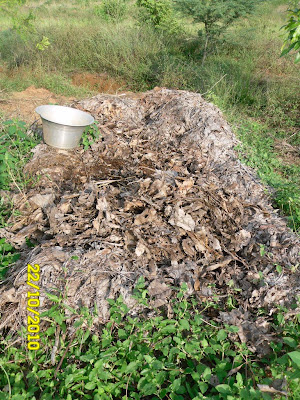as promised on
ragi-update, we are a month down from that post and bring to you our ragi post-harvest processing post.
we harvested the ragi in 3 installments due to differential maturing.
this is typically not the norm and is less efficient, but the field was a non-uniform one in terms of fertility, mulch cover and density of
cow-pea planted as inter-crop.
ragi processing is quite simple and a fun exercise.
step 1 - maturing the ears
the harvested ears of ragi is piled up as a heap onto a cloth, tied up and allowed to steam inside for 3-4 days. this process matures the batch and all the ears become a beautiful uniform brown.
care is to be taken to ensure that the ears are dry when harvesting, no water ingress in this process and the harvest must be done only in dry weather conditions.
here is the pile

close-up of heap

no this is not our laundry

and they all are brown

after this maturing, the ragi ears are thoroughly dried. depending on the time of the year, this could last 1-4 days.
now the fun part.
those who have driven through rural india would have certainly noticed straw-like grasses spread out on the road and vehicles trampling them.
this is the classic method of loosening the grains.
in our case, we simulated that process by whacking with a log aka
threshing.

after adequate bashing up, the pile looks like this. most of the grains would have settled down towards the bottom of the pile and the chaff at the top.

then we winnow. we use the wind to separate the heavier grain from the lighter chaff as we drop it from a height.

and when done, the grain remains on the tarpaulin and the chaff gets blown around the tarp.depending on the breeze, this process completed over 90% of the separation.


and whatever chaff remains is eliminated via the manual winnow.

and here we have the grain and the chaff.


our total harvest was around 12 kgs. considering that this was the second cropping attempt in this field, and the limited amount of external fertility we were able to add, and for a bunch of rookie farmers, this crop is an unqualified success :-)

our field was around 1/20 of an acre (approx 2500 sq feet).
the
yield from an acre varies from 1000-1500 kgs.
so our field should have yielded 50-75 kgs of ragi and hence we are at 20% productivity levels.
we have a list of improvements for the next time.
1.
soil fertility. add fertility prior to crop growing via cover crops, extra mulching, green manure and cowdung manure addition. over some years, the soil will reach and maintain its own optimal level of fertility as we move to
fukuoka's natural farming approach.
2.
transplanting density. we planted the saplings at 9 inch gaps. this will be halved.
3.
intercrop. definitely not using cow pea as intercrop. explore other nitrogen fixing small bush type crops.
we are now enjoying our
ragi koozhu breakfasts even more.























































